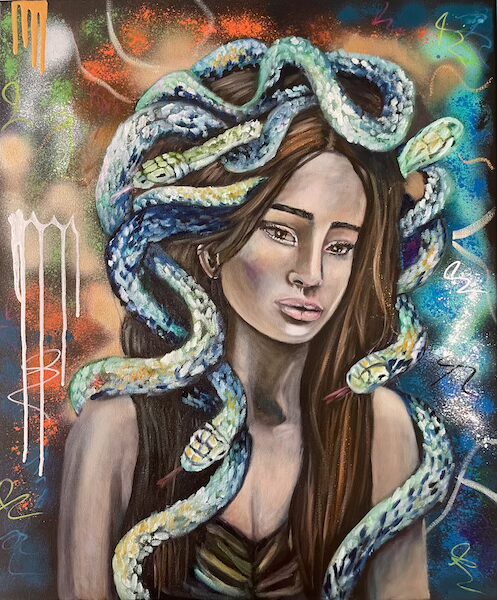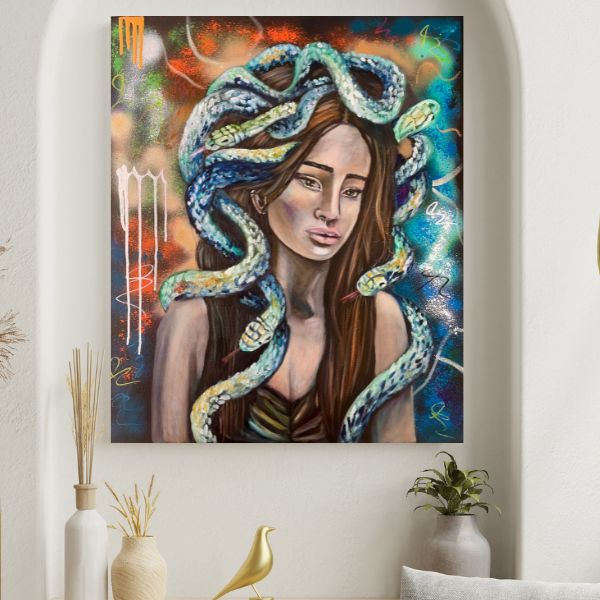
Medusa and her meaning: get your power back
Medusa is one of the most famous and multifaceted figures in Greek mythology. She is often depicted as a terrible gorgon whose gaze turned people to stone. But her story is more complex than that, and in modern times she is often seen as a symbol of transformation, female strength and self-empowerment.
Medusa in Greek mythology
In the oldest traditions, Medusa was a mortal woman of extraordinary beauty. She was the only one of the three Gorgons who was mortal, while her sisters Stheno and Euryale were immortal beings. In the best-known version of her story, Medusa was coveted by Poseidon in the temple of Athena and taken against her will. Athena, instead of punishing Poseidon, turned Medusa into a monster as punishment: her shiny hair became living snakes, and her gaze became so terrifying that it could petrify anyone who met it.
Medusa was later beheaded by the hero Perseus, who used her head as a weapon. But her story did not end with her death: from her blood sprang the winged horse Pegasus and the warrior Chrysaor, symbols of creation and new possibilities. Medusa's head was placed by Athena on her shield, the Aegis, to symbolize both protection and terror.
The snakes and Medusa - what they mean
Snakes accompany Medusa as one of their most striking features. In many cultures, snakes represent transformation, wisdom, death and rebirth. In Medusa's case, they are more than just a curse - they are a sign of her metamorphosis, of her new power and of the uncontrollable that she embodies. They remind us that destruction can also be a form of new beginning.
In a modern interpretation, Medusa's snakes can be seen as a symbol of inner strength and survival after trauma. They stand for the untamed, the wild and the powerful in us, which is often suppressed or perceived as dangerous, but is also deeply connected to our own power.
Medusa's message for today
Today, Medusa is often seen as a symbol of self-determination and transformation. Her image appears in feminist movements as she stands for women reclaiming their own strength and standing up to oppression. She is not just a mythical creature or a monster, but a figure who shows that it is possible to draw new strength from darkness and suffering.
Medusa reminds us that what others see as frightening or threatening is often a source of power. Her gaze can be interpreted as a protective shield, a kind of self-defense against those who would do her harm. She embodies the potential for transformation, for overcoming old wounds and for self-empowerment.
Her message is: You have the power over your self-image and can decide for yourself how you want to perceive yourself.


My painting "Medusa with snake head"
My painting "Medusa with snake head" picks up on these themes and brings them into a modern representation. I worked on a black canvas to emphasize the depth and the emergence from the darkness. Bright, sprayed colors create a contrast between the gloomy background and the vibrant, radiant expression.
I initially created Medusa itself in black and white as an underpainting and then worked it out further with fine, glazed layers of oil paint. This creates gentle transitions and a shimmering complexity that reflects the duality of darkness and light, menace and beauty. Her snakes are painted in vibrant shades of blue and green to emphasize the diversity and potential of transformation.
It is particularly striking that Medusa has opened her eyes in my painting. In many classical depictions, her eyes are blind or veiled - here, however, they are awake and conscious, as a sign that she determines her own history and her own power.
This image thus stands for the power that can arise from pain and transformation, and for the diversity of possibilities that lie hidden within each of us.


